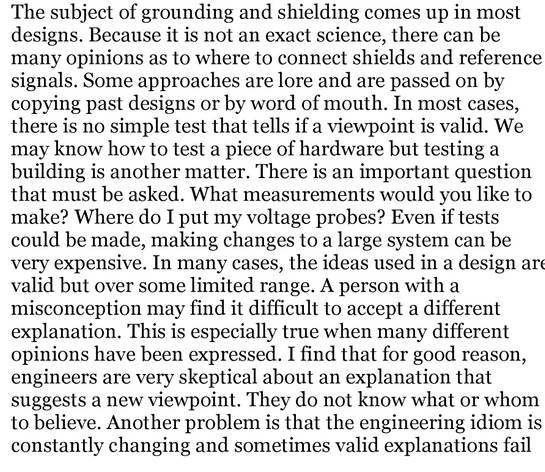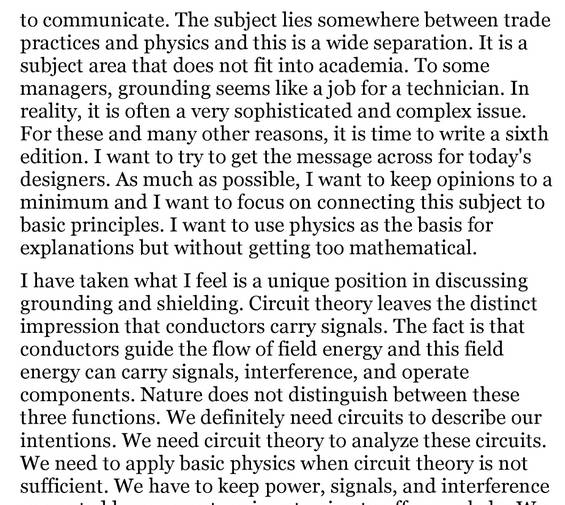Can you give some examples of actual detrimental results from this chassis grounding approach, please as I can't relate to what you say?
The thing is that RogerD isn't designing equipment - he & others have done aftermarket adjustments with, it seems, great audible improvement.
I agree if one has carte blanche & designing from ground up then these adjustments should not be needed for the device you have full design control over but you may be forgetting that your audio device usually has to be connected to other devices & this is maybe where things don't go as planned
What is the cause of this extra noise(?) from the larger gauge neutral wire?
I'm not sure how much sense it'll make if I try to give a very literal example of a piece of equipment so I'll keep it general. But for example I use coupling to chassis to break the parasitic nature, fairly often. For example a capacitor from a mounting screw to circuit ground. But to really see the issue I prefer to illustrate the problems that come from purposely increasing circulation of noise.
If you have a CMC and you put an X capacitor directly after it, that is a mistake 99% of the time. Prior to the cap a lot of noise simply would have gone elsewhere, maybe through mutual inductance, but you created an easier path through the CMC, to couple to the capacitor, than it would have had to go through whatever is down the line. The problem is the effect on the CMC, not that you're coupling noise. CMC's and just about anything in electronics are susceptible to issue of having nasties circulating through them. It often goes unnoticed when trying to measure, but can be audible early on. If it's bad enough you can see reductions in current, enough to stop things from working. I realize that is very general with an example not specific to analog and digital circuits or anything like that, but the principle is a reality. And the ground is no different, especially with common mode noise from the AC. I hope that is close enough to common language I wasn't just typing for you, jkenny.
As far as the larger gauge neutral wire I don't have a very definitive answer, as it's a phenomenon that I have not investigated any farther since I have the result I need; and it's rare to see that large of an imbalance in most cords. It just sounds really wrong. What we do know on principle is that the fields from the wires will change due to the imbalance, and with 115v that may be plenty to really infect a system. When it comes to interconnects it's not necessarily bad at all. They often benefit from what I can only describe as a small pinch on current that it causes, from experience with what sounds like what. Why and if all output/buffer/input stages are susceptible I do not know. Frankly for most stereo's it's a small benefit because they are not capable of the full delivery of what the music would actually drive if possible, free of all electronic bounds. It is my personal preference and suggestion, but as with pretty much all things audiophile, there is a subjective clause to it.
How can you reject more noise, when the nose is produced internally? Ferrite rings,blockers,EMI rejection materials don't work either. Granted a well designed cable can make a difference,but that's not a total problem solver. I have read many like comments but only a adequate parallel ground circuit will make a profound difference. The rest is just incremental and that is what the high end makes it's living on.
Roger, I believe 100% you hear what you hear. But that does not mean your reasoning is aligned with what's actually occurring. Your list is odd set of laymen conceptions, but the point is understood and taken. Thing is those do reduce noise as otherwise telecommunications (internet etc) would not exist if the principles could not be applied. They may not subjectively give you what you need in any way, shape, or form, but none the less do actually work. And yet even when working they may still have issues like I covered above, so subjectively even when working they can trash the sound when not applied well. If I can say one thing that seems evident about what you do,
very equal potentials will give you a lot of the described traits you get and want.
Noise is
everywhere. Voltage only divides and multiplies. We may get say a 12v + 12v battery to equal 24v in series, but to be sound in principle it's actually 12v x 2. Because of this behaviour we see noise going everywhere. What we can do to reduce it is using means of attenuation, and not encouraging it. Trying to simply create a better potential for it has serious limits. First off the safety ground is tied to the neutral in the breaker box. That means the safety ground's potential can only exceed neutrals in the sense that it has a ground rod to earth. The problem is the rod to earth need only be 25ohm or lower. That's actually a lot of resistance. So the potential has a limit of whatever the actual impedance is from the breaker panel back to the neighbourhood transformer along with the ground rod (
formula). This means depending on frequency the safety ground is in direct competition with the neutral for a lot of frequencies, and it's largely inductance dependent. If the safety ground has nothing to lower it's inductance, it isn't necessarily draining huge swaths of certain noise frequencies, in fact it can become a source for some noise. This is well illustrated in the constant battle with ground in studios. They are fighting to keep the resistance down not because they want to drain noise, but because they want to stop it from coming in! Studio tech's would probably love to float all the gear in many cases but it's not a good idea for many reasons.
None of this changes that you love your results. I encourage you to continue your path of discovery. I'm just pointing out that you talk about a lot of conjecture to everyone, including people that really understand electricity and have been employed with that knowledge to do things that require the opposite of what you sometimes say, to even be a reality.
As far as subjective qualities I pretty much believe whole heartedly that people can be on either side of the fence for what they enjoy, electrically speaking. The problem is good engineering that produces wrong results for many audiophiles, comes with common language that interferes with people's discussion about it. For example no audiophile really wants to say "I like equipment designed to allow certain amounts of RF noise into it, as it has some purposely poorly engineered RF rejection" but the simple reality is that
maybe as much as half of all audiophile actually do prefer it. The biggest mistake in the discussion is the assumption that RF in a system means audible RF from the speakers, but that relationship is simply not true in the least, ~99% of the time. The same goes for general noise, you don't hear the noise itself, you hear how it transformed the music.
So all in all, I am not "rejecting" noise in the path of the interconnects, but it works to say it that way for most people. What I'm doing is creating an impedance and attenuation that essentially leaves nothing notable after it. Noise flat out does go from one component to another, and a lot of it is picked up from the air. That internally generated noise in say a preamp, can certainly be shared to an amplifier. It goes back to division, it will divide into the amp if the potential is there.
I would disagree on the basis of my own and my customer's experience. All of my IC and power cables feature heavy gauge grounds and most people mention reduced noise when testing my cables. You wouldn't want the signal of IC cables to be as heavy as the grounds, in general, but it can work out depending on the conductor material. IMO it's a flaw made by a designer who has no clue when a SE IC cable has the same gauge ground and signal. They don't understand both the role the ground leg has in the audio system nor Ohm's law.
Dave, you already know I really like your cables. And the D4 I ordered is a winner. But I do believe balancing the gauges could lead to new better versions (for me), but maybe not for everyone. If I were to order more cables I would order custom balanced ones (don't be surprised to hear from me in the future for cables). As is your cables are very close, so in general it's likely more of a benefit for most, including noise. Noise is not my primary concern with cables themselves, btw. You certainly are not wrong that balancing the two can be tricky because you do not want too large of a signal gauge, as gauge itself can form a bit of audio band attenuation in the "bad zone" between not big enough and not small enough.
I hate when people refer to impedance in these debates and do not specify clearly the frequencies they are addressing.

High-end sound quality, particularly using digital, deals with minimal effects that affect electrical signals, most of them are not clearly understood. Most audio devices we are using are not prepared to deal with existing RF interference, that has moved up in the spectrum during the last twenty years.
The RF frequency hike does leave us in a funny position. The average connector isn't good enough to keep out the really high stuff at all. Few boxes are even tightly enough sealed to not allow it to creep in. How much does it matter? I'm not sure with the really high RF junk. I believe the shape of the conductors may have more audible influence for audio concerns. But my sympathies go out to anyone dealing it in non-audio fields. I don't think this matters much for our discussion.


















